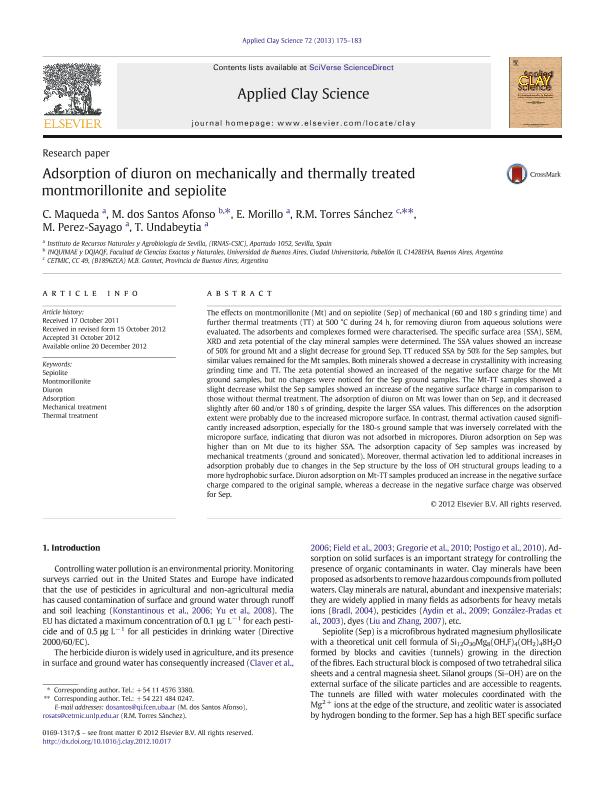Artículo
Adsorption of diuron on mechanically and thermally treated montmorillonite and sepiolite
Maqueda, C.; Dos Santos Afonso, María; Morillo, E.; Torres Sanchez, Rosa Maria ; Perez Sayago, M.; Undabeytia, T.
; Perez Sayago, M.; Undabeytia, T.
 ; Perez Sayago, M.; Undabeytia, T.
; Perez Sayago, M.; Undabeytia, T.
Fecha de publicación:
01/2013
Editorial:
Elsevier Science
Revista:
Applied Clay Science
ISSN:
0169-1317
Idioma:
Inglés
Tipo de recurso:
Artículo publicado
Clasificación temática:
Resumen
The effects on montmorillonite (Mt) and on sepiolite (Sep) of mechanical (60 and 180 s grinding time) and further thermal treatments (TT) at 500 °C during 24 h, for removing diuron from aqueous solutions were evaluated. The adsorbents and complexes formed were characterised. The specific surface area (SSA), SEM, XRD and zeta potential of the clay mineral samples were determined. The SSA values showed an increase of 50% for ground Mt and a slight decrease for ground Sep. TT reduced SSA by 50% for the Sep samples, but similar values remained for the Mt samples. Both minerals showed a decrease in crystallinity with increasing grinding time and TT. The zeta potential showed an increased of the negative surface charge for the Mt ground samples, but no changes were noticed for the Sep ground samples. The Mt-TT samples showed a slight decrease whilst the Sep samples showed an increase of the negative surface charge in comparison to those without thermal treatment. The adsorption of diuron on Mt was lower than on Sep, and it decreased slightly after 60 and/or 180 s of grinding, despite the larger SSA values. This differences on the adsorption extent were probably due to the increased micropore surface. In contrast, thermal activation caused signifi- cantly increased adsorption, especially for the 180-s ground sample that was inversely correlated with the micropore surface, indicating that diuron was not adsorbed in micropores. Diuron adsorption on Sep was higher than on Mt due to its higher SSA. The adsorption capacity of Sep samples was increased by mechanical treatments (ground and sonicated). Moreover, thermal activation led to additional increases in adsorption probably due to changes in the Sep structure by the loss of OH structural groups leading to a more hydrophobic surface. Diuron adsorption on Mt-TT samples produced an increase in the negative surface charge compared to the original sample, whereas a decrease in the negative surface charge was observed for Sep.
Archivos asociados
Licencia
Identificadores
Colecciones
Articulos(CETMIC)
Articulos de CENTRO TECNOL.DE REC.MINERALES Y CERAMICA (I)
Articulos de CENTRO TECNOL.DE REC.MINERALES Y CERAMICA (I)
Citación
Maqueda, C.; Dos Santos Afonso, María; Morillo, E.; Torres Sanchez, Rosa Maria; Perez Sayago, M.; et al.; Adsorption of diuron on mechanically and thermally treated montmorillonite and sepiolite; Elsevier Science; Applied Clay Science; 72; 1-2013; 175-183
Compartir
Altmétricas



